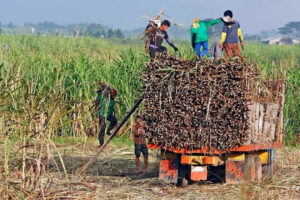By Luisa Maria Jacinta C. Jocson, Reporter
THE farming industry said a liberal import regime for sugar could result in a repeat of the hardships endured by rice farmers when that commodity was subjected to tariffication.
“I have a few reservations (about sugar tariffication). The worry here is we might be jumping from the frying pan into the fire. What is happening now looks like a replay of what happened to rice in 2018. During that time, the rice inventory of the National Food Authority (NFA) fell to as low as a one- or two-day supply,” Federation of Free Farmers Chairman Leonardo Q. Montemayor said in an interview with ANC on Thursday.
“During the past three years, rice farmers have lost, based on data, at least P70 billion because of the depressed palay (unmilled rice) prices every year due to the non-stop entry of imports,” he added.
Bangko Sentral ng Pilipinas Governor Felipe M. Medalla on Wednesday raised the possibility of implementing a tariffication scheme on the sugar industry, emulating the Rice Tariffication Law of 2019.
The law liberalized the entry of foreign rice, whose importers needed to pay a 35% tariff on shipments from Southeast Asia, raising revenue for the government.
In compensation for exposing farmers to foreign competition, the law set up the Rice Competitiveness Enhancement Fund, which gets P10 billion a year from tariffs to support farm mechanization, credit assistance, and seed development, among others.
“The problem is when you allow imports… you really need the bureaucracy to decide,” Mr. Medalla said, adding that the rice model forces a choice on tariff levels to protect the domestic industry. “Do you want 100% tariff? Do you want 75%? So let the debate be on the tariff level,” Mr. Medalla said at an economic forum.
“Let people who bet their money on whether there will be a shortage or surplus do the importing, because they have the biggest incentive to get their forecast right, because if you forecast a shortage and import and there’s no shortage, you lose your money,” he added.
Mr. Medalla said that tariffs are a “transparent and efficient” scheme compared with import allocations decided by bureaucrats.
“The nice thing about tariffs is the revenue that’s raised can be used to target assistance, in this case, the farmers. So that’s another nice experience rather than bureaucrats who may actually get under the table payments for giving import allotments. At least the government captures the price difference,” he added.
According to Mr. Montemayor, a “dangerous” aspect of tariffication is that the government will be unable to regulate illegal imports.
“The government might lose the ability to regulate the industry’s fly-by-night importers or profiteers. We will be completely helpless. This might happen to our sugar sector if we are not careful… we want to make sure our farmers and workers are protected,” he said.
Mr. Montemayor said that the priority should be directed towards investing in modernization and providing subsidies to offset high input costs.
“With or without sugar tariffs, it’s critical that we strengthen our sugar industry. What happened in rice is that they totally liberalized the rice industry without (raising) the competitiveness (of rice farmers),” he said.
“It’s critical we start soon on the problem of fertilizer; subsidies for sugar planters, modernization for sugar mills, research and development for better varieties. We have to look for funding and support. That cannot be done overnight. It will take years,” he added.
Samahang Industriya ng Agrikultura Executive Director Jayson H. Cainglet said that the tariffication scheme can be replicated for other agricultural commodities, raising sufficient revenue that can go directly to the benefit of the workers.
“We’d rather that the end users are the ones importing. It should not be an unknown trader or importer,” he added in a Viber message.
